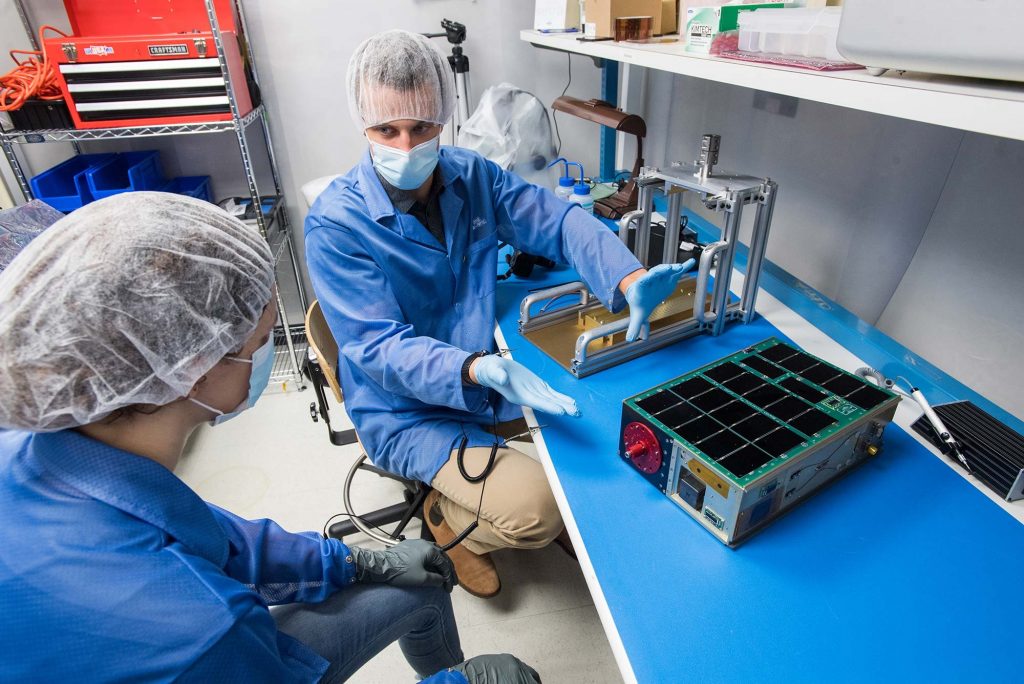
Two small research satellites that are launching as part of NASA’s 34th Educational Launch of Nanosatellites (ELaNa) mission promise exciting insights for the university researchers that developed them. The CubeSats will launch as secondary payloads when Landsat 9 lifts off at 11:11 a.m. PDT (2:11 p.m. EDT) Monday, Sept. 27, from Vandenberg Space Force Base in California.
Landsat 9, launching aboard a United Launch Alliance Atlas V rocket, is a joint mission between NASA and the U.S. Geological Survey and will continue a nearly 50-year legacy of Earth-observing Landsat satellites. The two CubeSats will hitch a ride in the spacecraft’s secondary payload adapter.
The Colorado Ultraviolet Transit Experiment (CUTE) from the University of Colorado at Boulder, and Cusp Plasma Imaging Detector (CuPID) from Boston University, are shoebox-sized spacecraft, each measuring approximately 8 inches by 4 inches by 13 inches.
CUTE aims to provide a better understanding of atmospheric loss on all types of planets by measuring atmospheric escape rates from giant exoplanets. Atmospheric escape is the loss of mass from a planet’s atmosphere over time. This phenomenon can affect a planet’s long-term physical properties, including the sizes of extrasolar planets and the habitability of rocky planets.
CUTE will target 10 to 12 exoplanets during its eight-month science mission, conducting a survey of heavy elements, such as iron and magnesium, escaping from the atmospheres of the most extreme planets in the galaxy.
“Measuring atmospheric escape rates allows astronomers and planetary scientists to better understand the physics behind atmospheric loss,” said Dr. Kevin France, associate professor in the Department of Astrophysical and Planetary Sciences at the University of Colorado Boulder and principal investigator of the CUTE mission. “This in turn allows us to better understand the atmospheres of known planets and predict the properties of extrasolar planets we have not yet discovered.”

The spacecraft will carry out its mission using a magnifying spectrograph fed by a rectangular Cassegrain telescope. CUTE is sponsored by NASA’s Science Mission Directorate Astrophysics Division.
CuPID will study how energy from the Sun is deposited into the Earth’s magnetosphere – a protective bubble around our home planet. This mission could solve long-standing questions on space weather and solar wind magnetosphere coupling. CuPID will measure X-rays in space using a novel wide field-of-view telescope to image reconnection signatures in the magnetosphere. Reconnection occurs when the Sun is active enough that its magnetic field fuses with the Earth’s. Using this soft X-ray telescope, CuPID will generate first-of-their-kind images of this phenomenon.
“Launch is scheduled to occur during a lecture of an orbital dynamics course I’m teaching this fall. I plan to have the class online watching. I’m not sure I could think of a better real-world example of the material,” said Dr. Brian Walsh, CuPID’s principal investigator, and professor of Mechanical Engineering and member of the Center for Space Physics at Boston University.
The CuPID mission, led by Boston University in Massachusetts, is a collaboration with NASA Goddard Space Flight Center; Johns Hopkins University, Baltimore, Maryland; Merrimack College, North Andover, Massachusetts; Drexel University, Philadelphia, Pennsylvania; and the University of Alaska, Fairbanks; and is supported by NASA’s Science Mission Directorate Heliophysics Division and Small Satellite Project Office.
NASA’s CubeSat Launch Initiative (CSLI) selected the CubeSats assigned to the ELaNa 34 mission by NASA’s Launch Services Program (LSP) based at the Kennedy Space Center in Florida. LSP manages the ELaNa manifest, and CSLI provides launch opportunities for small satellite payloads built by universities, high schools, NASA Centers, and non-profit organizations.
To date, NASA has selected 202 CubeSat missions, 122 of which have been launched into space, with 43 more missions scheduled for launch within the next 12 months. The selected CubeSats represent participants from 42 states, the District of Columbia, Puerto Rico, and 102 unique organizations. CSLI’s 2021 Announcement of Partnership Opportunity is open for CubeSat proposals until Nov. 19, 2021.
Stay connected with these CubeSat missions on social media by following NASA’s Launch Services Program on Facebook and Twitter.
